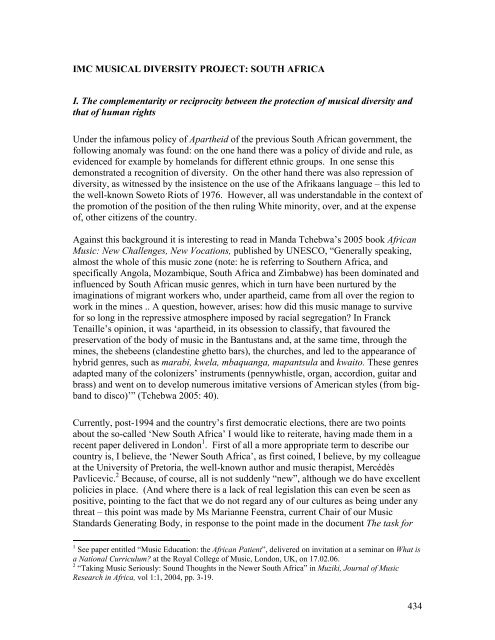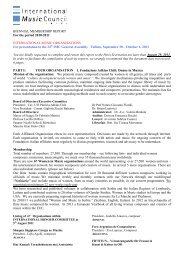Appendix 6 - International Music Council
Appendix 6 - International Music Council
Appendix 6 - International Music Council
You also want an ePaper? Increase the reach of your titles
YUMPU automatically turns print PDFs into web optimized ePapers that Google loves.
IMC MUSICAL DIVERSITY PROJECT: SOUTH AFRICA<br />
I. The complementarity or reciprocity between the protection of musical diversity and<br />
that of human rights<br />
Under the infamous policy of Apartheid of the previous South African government, the<br />
following anomaly was found: on the one hand there was a policy of divide and rule, as<br />
evidenced for example by homelands for different ethnic groups. In one sense this<br />
demonstrated a recognition of diversity. On the other hand there was also repression of<br />
diversity, as witnessed by the insistence on the use of the Afrikaans language – this led to<br />
the well-known Soweto Riots of 1976. However, all was understandable in the context of<br />
the promotion of the position of the then ruling White minority, over, and at the expense<br />
of, other citizens of the country.<br />
Against this background it is interesting to read in Manda Tchebwa’s 2005 book African<br />
<strong>Music</strong>: New Challenges, New Vocations, published by UNESCO, “Generally speaking,<br />
almost the whole of this music zone (note: he is referring to Southern Africa, and<br />
specifically Angola, Mozambique, South Africa and Zimbabwe) has been dominated and<br />
influenced by South African music genres, which in turn have been nurtured by the<br />
imaginations of migrant workers who, under apartheid, came from all over the region to<br />
work in the mines .. A question, however, arises: how did this music manage to survive<br />
for so long in the repressive atmosphere imposed by racial segregation? In Franck<br />
Tenaille’s opinion, it was ‘apartheid, in its obsession to classify, that favoured the<br />
preservation of the body of music in the Bantustans and, at the same time, through the<br />
mines, the shebeens (clandestine ghetto bars), the churches, and led to the appearance of<br />
hybrid genres, such as marabi, kwela, mbaquanga, mapantsula and kwaito. These genres<br />
adapted many of the colonizers’ instruments (pennywhistle, organ, accordion, guitar and<br />
brass) and went on to develop numerous imitative versions of American styles (from bigband<br />
to disco)’” (Tchebwa 2005: 40).<br />
Currently, post-1994 and the country’s first democratic elections, there are two points<br />
about the so-called ‘New South Africa’ I would like to reiterate, having made them in a<br />
recent paper delivered in London 1 . First of all a more appropriate term to describe our<br />
country is, I believe, the ‘Newer South Africa’, as first coined, I believe, by my colleague<br />
at the University of Pretoria, the well-known author and music therapist, Mercédès<br />
Pavlicevic. 2 Because, of course, all is not suddenly “new”, although we do have excellent<br />
policies in place. (And where there is a lack of real legislation this can even be seen as<br />
positive, pointing to the fact that we do not regard any of our cultures as being under any<br />
threat – this point was made by Ms Marianne Feenstra, current Chair of our <strong>Music</strong><br />
Standards Generating Body, in response to the point made in the document The task for<br />
1 See paper entitled “<strong>Music</strong> Education: the African Patient”, delivered on invitation at a seminar on What is<br />
a National Curriculum? at the Royal College of <strong>Music</strong>, London, UK, on 17.02.06.<br />
2 “Taking <strong>Music</strong> Seriously: Sound Thoughts in the Newer South Africa” in Muziki, Journal of <strong>Music</strong><br />
Research in Africa, vol 1:1, 2004, pp. 3-19.<br />
434



